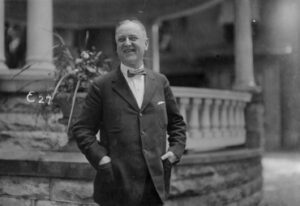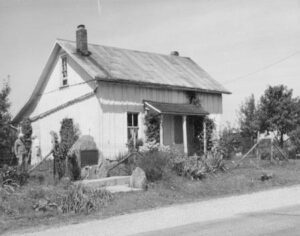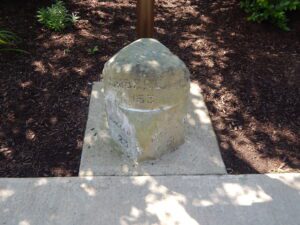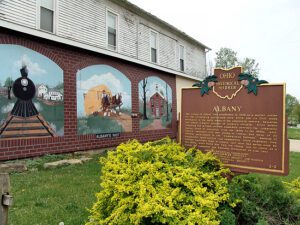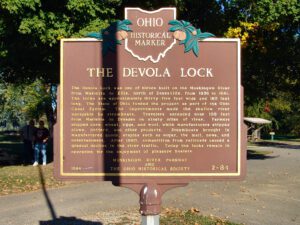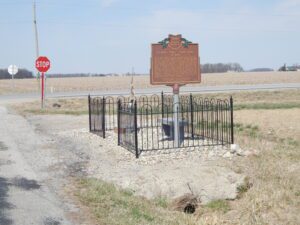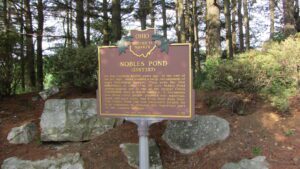, OH
One of Ohio’s most influential politicians in the early 20th century, Washington Court House native Harry Daugherty (1860-1941) was widely known as a “President-maker” and served instrumental roles in President Warren G. Harding’s administration, culminating a long career in state and national politics. As Attorney General from 1921 to 1924, Daugherty established the first federal women’s penitentiary, recommended former president William Howard Taft to the Supreme Court, and ended a controversial 1922 railroad strike. Implicated in scandals complicated by the suicide of his assistant and fellow Fayette County native Jess Smith, Daugherty was eventually cleared in congressional investigations and two bribery trials, and subsequently published an insider’s account of the Harding Administration. Both Daugherty and Smith are buried in Washington Cemetery.
, OH
One of America’s best-known sport shooters and entertainers of the late 1800s, Annie Oakley was born Phoebe Ann Mosey (or Mozee) north of Versailles in Darke County in 1860. She achieved local fame for her shooting ability as a hunter while still in her teens. By 1885 Oakley was a star performer in Buffalo Bill’s Wild West. With husband and manager Frank Butler, she refined a shooting act and image that appealed to late 19th century notions of a romanticized but vanishing West. Throughout her 30-year performing career, Oakley provided honest entertainment in a deception-prone industry while demonstrating widening opportunities for women. She retained her Ohio ties throughout her life and is interred at Brock Cemetery, eleven miles north of Greenville.
, OH
The earliest highway signs along the National Road (Route 40) in Ohio were milestones located at one-mile intervals along the north side of the roadway. Each stone indicated the distance to Cumberland, Maryland, the eastern terminus of the National Road, and to the nearest cities and villages for both east and westbound travelers.
, OH
The village of Albany was established in 1838 as a market center for the surrounding agricultural area, which saw its first white settlement in the early years of the nineteenth century. Education was always a major concern of Albany’s citizens. Since public schooling was minimal, private academies provided the community various levels of education from the 1840s to the 1880s. Anti-slavery sentiment also was strong in Albany, and many of its citizens participated in the “Underground Railroad.” Because of educational opportunities and sympathetic white neighbors, free African-Americans came to Albany, but most had moved away by the 1930s. After World War Two, the village lost its status as a center for commerce and business.
, OH
The Devola Lock was one of eleven built on the Muskingum River from Marietta to Ellis, north of Zanesville, from 1836 to 1841. The locks are approximately thirty-five feet wide and 160 feet long. The State of Ohio funded the project as part of the Ohio Canal System. The improvements made the shallow river navigable by steamboats. Travelers ascended over 100 feet from Marietta to Dresden on ninety miles of river. Farmers shipped corn, wheat, eggs, and wool, while manufacturers shipped goods, staples such as sugar, the mail, news, and entertainment. After 1880, competition from railroads caused a gradual decline in the river traffic. Today the locks remain in operation for the enjoyment of pleasure boaters.
, OH
One of Ohio’s greatest manhunts ended here on the morning of July 23, 1948. Robert M. Daniels and John C. West, parolees from the state prison in Mansfield, had gone on a killing spree that left six people dead. Driving west on U.S. Route 224 in a stolen auto transport truck, the pair approached this intersection and encountered a roadblock. It was manned by Van Wert County Sheriff Roy Shaffer, Frank Friemoth, the county game warden, and Sergeant Leonard Conn of the Van Wert city police. West was driving the truck; Daniels was asleep in a car overhead. As Sheriff Shaffer climbed onto the truck and apprehended Daniels, West leaped from the cab and shot Conn in the chest and Friemoth in the arm. Conn returned fire and killed West. The officers survived their wounds. Daniels was convicted, sentenced to die, and electrocuted at the Ohio Penitentiary in Columbus on January 3, 1949. This marker pays tribute to all law enforcement officers who risk their lives to protect the citizens of their communities.
, OH
Tallmadge was established in 1807 by David Bacon as a Congregational community. In 1821 local landowners donated timber to build this church, designed and constructed by one of Ohio’s first architects, Col. Lemuel Porter. Dedicated on September 8, 1825, the structure is considered to be a perfect example of the pure Connecticut-type of Federal architecture. It is the oldest Ohio church to be continuously occupied as a place of worship.
, OH
On this location 11,000 years ago, at the end of the Ice Age, there existed a large encampment of early Paleoindian hunters. They were the first inhabitants of Ohio. The 25-acre Nobles Pond archaeological site is one of the largest Clovis Paleoindian sites in North America. It documents how these early people obtained raw materials, made and used tools, and lived their daily lives. The Nobles Pond site was excavated largely by local volunteers to preserve this important part of our common heritage.


